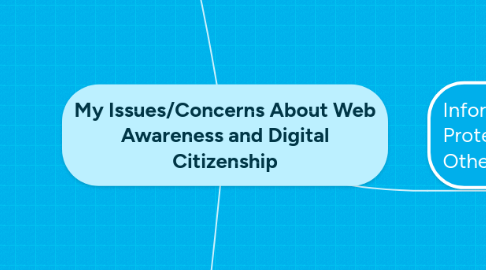
1. Instilling Respect for Others Online
1.1. Provide Equal Access Among Students
1.1.1. Less Participation in Society & Class
1.1.2. Less Productive Citizens
1.1.3. Ensure No One is Denied Digital Access
1.1.4. Create Media (Not just consume)
1.2. Responsible for Teaching Laws and Ethics (Netiquette)
1.2.1. Don't Plagarize
1.2.1.1. Ask Permission From Author
1.2.1.2. Cite Sources
1.2.1.3. Fair Use
1.2.1.4. Teachers Model Documenting/Sourcing Process
1.2.2. Responsible for Actions
1.2.3. Be Effective/Safe/Legal Consumers
1.2.4. Proper Conduct Before Using Technology
1.2.5. Active but Ethical Participants
1.3. Inform Students They Are Accountable for Their Actions
1.3.1. Stealing Intellectual Property
1.3.1.1. Illegal Downloads
1.3.1.1.1. Music
1.3.1.1.2. Software
1.3.1.2. Plagarism
1.3.1.2.1. Copy/Paste Copyrighted Pictures for School Reports
1.3.1.2.2. Stealing Ideas and Documents
1.3.2. Cyber Bullying
1.3.2.1. Do no harm to others
1.3.2.2. Promote Ethical Behaviours Online
1.3.2.3. Increase Awareness
1.3.2.3.1. Amanda Todd
1.3.3. Trojan Horses/Worms
1.3.4. Identity Theft
1.3.5. Hacking
1.3.6. Buying/Selling Illegal Goods/Services Online
1.3.6.1. Porn
1.3.6.2. Music
1.3.6.3. Gambling
2. Educating & Improve Digital & Media Literacy
2.1. Improve My Own Digital Literacy
2.1.1. Maintain 21st Century Classroom
2.1.1.1. Use/Teach New Technology in Classroom
2.1.1.2. Keep Up to Date on New Advances
2.1.1.3. Social Media Sites Utilized
2.1.1.3.1. Teach Students to Make Good Decisions
2.1.1.4. Increase Student Opportunities for:
2.1.1.4.1. Collaboration
2.1.1.4.2. Connection
2.1.1.4.3. Learning
2.1.1.4.4. Community
2.1.1.4.5. Access to Information
2.1.2. Listen to their Stories
2.1.2.1. What are they doing online?
2.1.2.2. What are their existing skills?
2.1.2.2.1. How to Protect themselves?
2.1.2.2.2. Plan What to Teach Accordingly
2.1.2.2.3. Adapt Policy Accordingly
2.1.2.3. Tough to Keep Up
2.2. Improve Students' Digital Literacy
2.2.1. Prepation for Future Careers/Lives
2.2.1.1. Growing Global Economy = Global Job Competition
2.2.1.2. Need to Know New Technology Quickly/Appropiratly
2.2.1.2.1. New Advances = Increase in New Technologies
2.2.1.3. Future Job Market Relatively Unknown
2.2.1.3.1. New Technology = Jobs Duties/Responsibilities Change
2.2.2. Differentiate Good Information vs. Misinformation
2.2.2.1. Judge Authenticity
2.2.2.2. Authority
2.2.2.3. Coverage
2.2.2.4. Objectivity
2.2.2.5. Accuracy
2.2.2.6. Currency
3. Inform How Students Can Protect Themselves and Others
3.1. Balance Rights and Responsibilities to Create/Sustain Community
3.1.1. Students have a Right to...
3.1.1.1. Privacy
3.1.1.1.1. Beware Marketers
3.1.1.1.2. Beware Predators
3.1.1.1.3. Consider Information You're Publishing
3.1.1.2. Free Speech
3.1.1.3. etc.
3.1.2. It Applies to ALL Students
3.1.2.1. One's Rights Doesn't Eclipse Another's
3.1.2.2. Use Technology Appropriately
3.2. Stay SAFE & SECURE online
3.2.1. Protect Against Human Threats
3.2.1.1. Online Predators
3.2.1.1.1. Beware the Wolf, Little Red Riding Hood
3.2.1.1.2. All is not as it seems
3.2.1.2. Cyber Bullies
3.2.1.3. Sexting
3.2.1.3.1. Snap Chat
3.2.1.3.2. When Private Becomes Public
3.2.1.4. Identity Thieves
3.2.1.5. Hackers
3.2.2. Electronic Precautions
3.2.2.1. Backup Data
3.2.2.2. Virus Protection
3.2.2.3. Surge Control
3.2.3. Digital Footprint
3.2.3.1. Online Identity
3.2.3.1.1. What Impression are you making?
3.2.3.1.2. Can harm you down the road
3.2.3.2. Awareness of Information being Disseminated
3.2.3.3. Think Before You Click
3.2.4. Establish Digital Codes of Conduct = Good School Environment
3.2.4.1. Welcoming
3.2.4.2. Caring
3.2.4.3. Respectful
3.2.4.4. Safe
3.2.5. Prevent Access to Sexually Explicit Materials
3.2.5.1. Often Inaccurate & Harmful
3.2.5.1.1. Causes Stress
3.2.5.1.2. Distorts Values and Perceptions of Healthy Sexual Relationships
3.2.5.1.3. Increases Victimization/Blurs Boundaries
3.2.5.1.4. Encourages Risky Behaviours
3.2.5.1.5. Prematurely Sexulizes Children
3.2.5.2. What Teachers & Parents Can Do:
3.2.5.2.1. Supervise/Be Aware
3.2.5.2.2. Set Limits/Parental Controls/Filters
3.2.5.2.3. Explain Media's False Representations
3.2.5.2.4. Openly/Honestly Discus Healthy Relationships & Sexuality
3.2.5.2.5. Promote Healthy Body Image/Self Worth
3.2.5.2.6. Good Pictures Bad Pictures (Book)
3.3. Risks to Health and Welfare
3.3.1. Ergonomic Stress
3.3.1.1. Eye Stress
3.3.1.2. Hearing Loss
3.3.1.3. Repetitive Physical Stress
3.3.2. Internet Addiction

